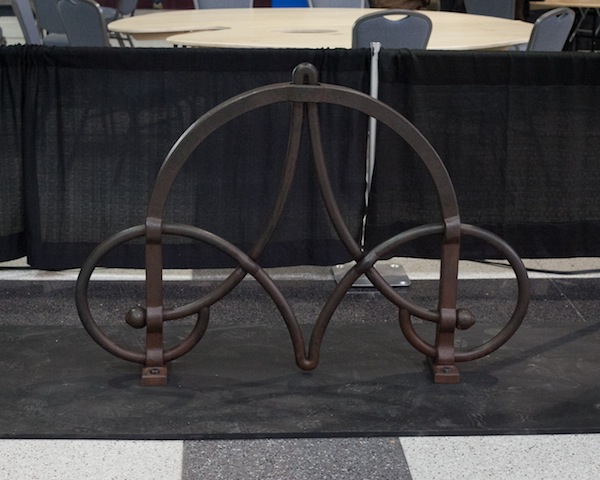
Bike Racks and their designers enjoy time in the spotlight
By Nicholas Mirra, Bicycle Coalition of Greater Philadelphia
After a successful public unveiling at the Philadelphia Flower Show, the artist-designed bike racks traveled half a mile to their new temporary home: the art gallery space in City Hall. Hosted by the Office of Arts, Culture, and the Creative Economy, the racks are on public display until June 13th. Last week they received special attention, both of a critical and a celebratory nature.
On Monday, April 7th, Bicycle Coalition and OACCE staff met Philadelphia Inquirer architecture critic (and newly-minted Pulitzer Prize winner) Inga Saffron in the gallery space. She had heard about the racks and wanted to see them for an Inquirer piece. Her piece, she said, would consider their aesthetic merit but she also wanted to see how they functioned as bicycle racks. Towards that end, she brought her fender and pannier-toting bicycle to put the racks through their paces.
The process for soliciting designs for these racks included developing size specifications such that the pieces would work as racks. A second compatibility check took place during the actual selection process. But this was the first time someone entirely outside of the process arrived asking the pertinent question: “Do they work as bicycle racks?” Despite all of the attention and double-checking paid to that question, there was a little trepidation in the room as Inga, with photographer in tow, locked her bike to each rack in turn.
Two days later, the racks received a different kind of inspection. The OACCE held an artists’ reception in the gallery space. More than 40 people attended to meet some of the designers themselves, as well as the artists behind a companion exhibit featuring art pieces made from, and inspired by, bicycles and their components. It was a lovely evening, and the diversity of people, interests, and backgrounds in the room spoke to bicycling’s cross-cultural appeal.
As for the racks as racks? One of the seven racks on display in OACCE’s gallery space gave Inga Saffron some locking trouble, but the other six performed the utilitarian aspect of their purpose without a hitch. And Inga’s report was pretty favorable, which for a critic known for not pulling punches, was a pretty nice win for the project.
Recent Content
-
Artsarticle ·
-
Artsarticle ·
-
Artsarticle ·

